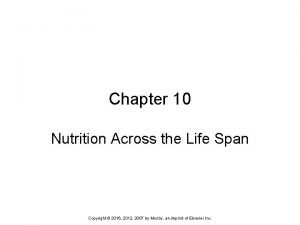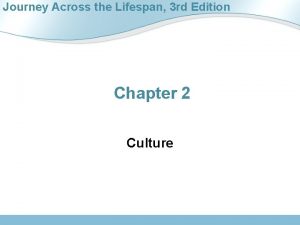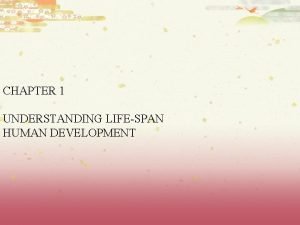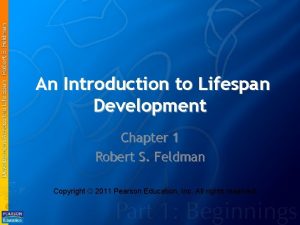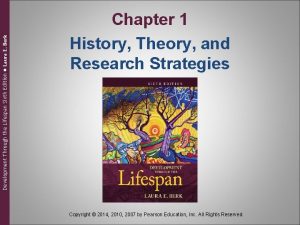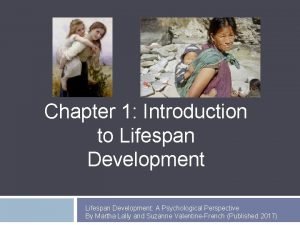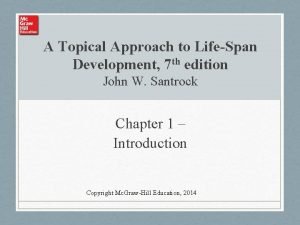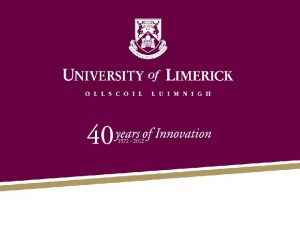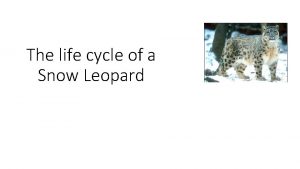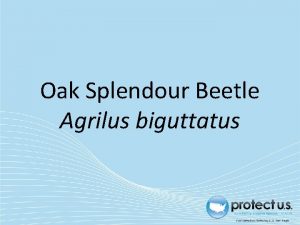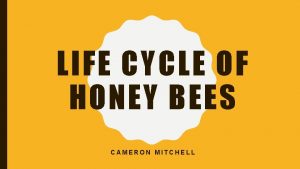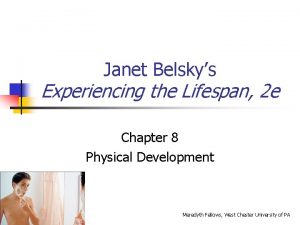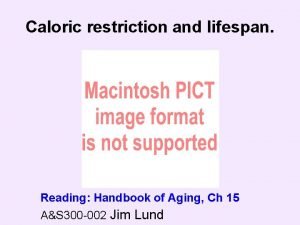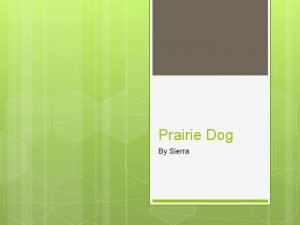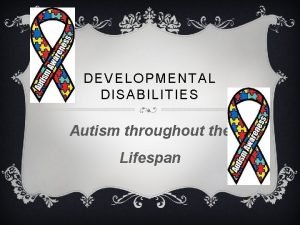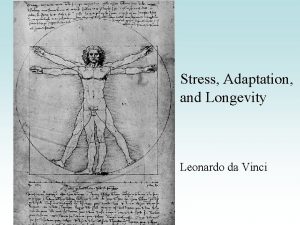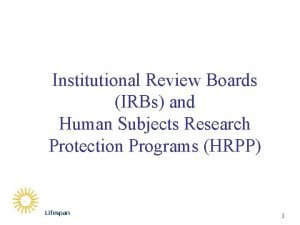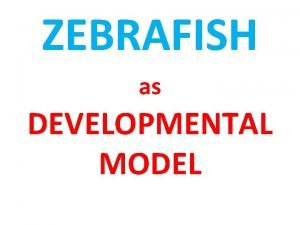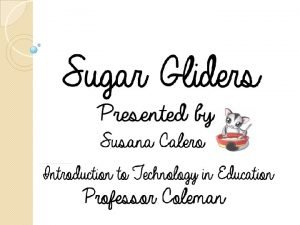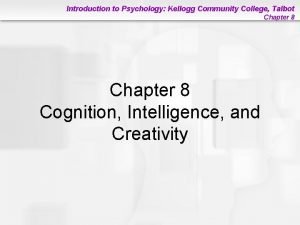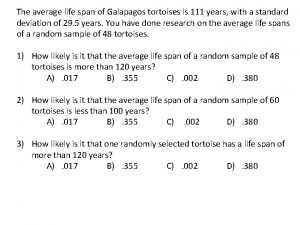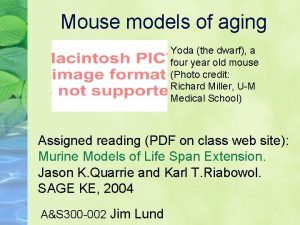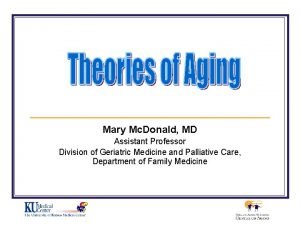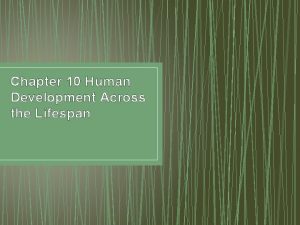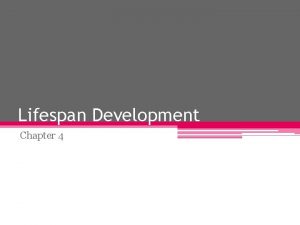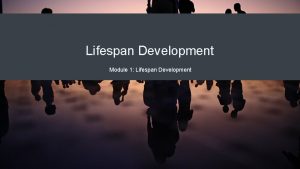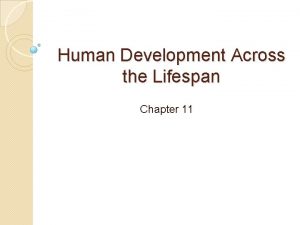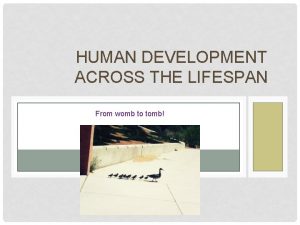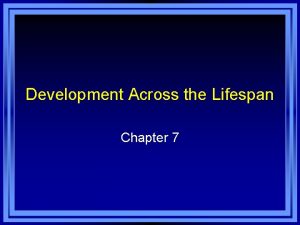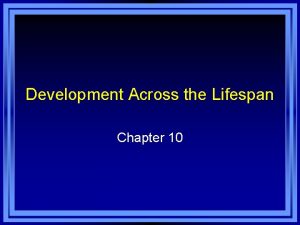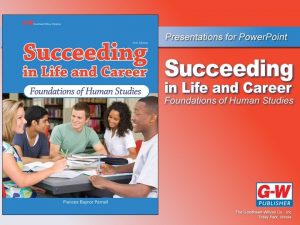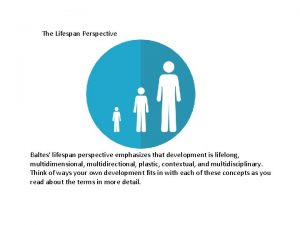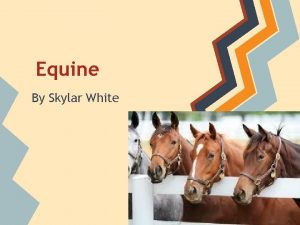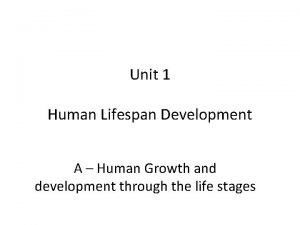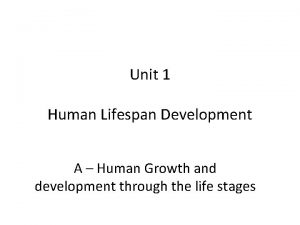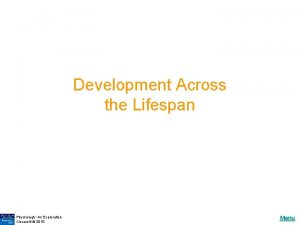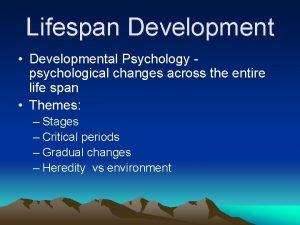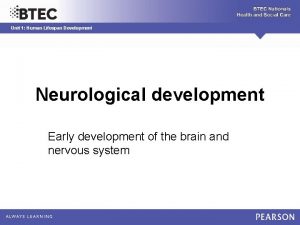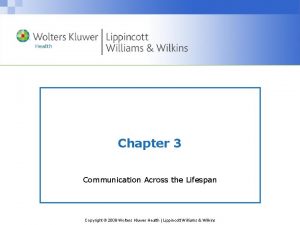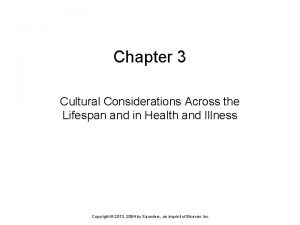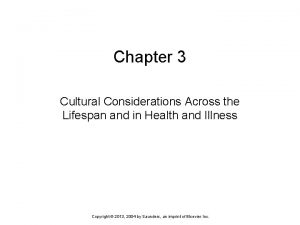Chapter 10 Human Development Across the Lifespan Development




















































- Slides: 52

Chapter 10 Human Development Across the Lifespan

• Development = sequence of age-related changes that occur as person progresses from conception - death.

PROGRESS BEFORE BIRTH: PRENATAL DEVELOPMENT

• prenatal period = from conception to birth, usually encompassing nine months of pregnancy • placenta = structure that allows oxygen & nutrients to pass into fetus from mother’s bloodstream & bodily wastes to pass out to mother • Source: Microsoft Clip. Art

The Course of Prenatal Development • Germinal (first 2 weeks) • Embryonic (2 weeks - 2 months) = period of great vulnerability, as most physiological structures are being formed • Source: Micro. Soft Clip. Art

The Course of Prenatal Development • Fetal stages (2 months - birth) = brings rapid growth as physiological systems mature • Threshold of viability at around 23 -26 weeks. • Source: Microsoft Clip. Art

Environmental Factors & Prenatal Development • Nutrition • Severe maternal malnutrition increases risk of birth complications & neurological deficits for newborn • Stress and Emotion • Prospective mothers’ emotional reactions to stressful events can disrupt delicate hormonal balance that fosters healthy prentatal development

Environmental Factors & Prenatal Development • Drug Use • Maternal use of illicit drugs can be dangerous to unborn child. • Alcohol Consumption • Even normal social drinking & routine tobacco use can be hazardous during prenatal development

Environmental Factors & Prenatal Development • Maternal Illness • can interfere with prenatal development. • Environmental Toxins • Exposure during prenatal development can “program” fetal brain in ways that influence vulnerability to various types of illness decades later

THE WONDROUS YEARS OF EARLY CHILDHOOD

Exploring the World: Motor Development • Motor development = progression of muscular coordination required for physical activities • Maturation = development that reflects gradual unfolding of one’s genetic blueprint

Understanding Developmental Norms • Developmental norms = typical (median) age at which individuals display various behaviors & abilities

Early Emotional Development: Attachment • Attachment = close emotional bonds of affection that develop between infants & their caregivers. • separation anxiety—emotional distress seen in many infants when separated from people with whom they are attached

Theories of Attachment • Bowlby evolutionary theory that attachment relationships have survival value. • Attachment emerges out of an interplay between infant & parent.

Patterns of Infant/Mother Attachment • Secure = play & explore comfortably with parent present, become visibly upset when leaves, & are quickly calmed by their return • Anxious-ambivalent = anxious when parent is near & protest excessively when leaves, but are not comforted when they return

Patterns of Infant/Mother Attachment • Avoidant = seek little contact with their parent and often are not distressed when they leave

Attachment Theory and its Effects on Adult Relationships

Learning to Communicate: Language Development • 1 st words around 1 st birthday • Vocab spurt begins 18 months

Combining Words • Combine words by the end of 2 nd year • Early sentences are telegraphic • mainly of content words; articles, prepositions, & other less critical words omitted.

PERSONALITY & COGNITIVE DEVELOPMENT IN CHILDHOOD

Becoming Unique: Personality Development • Stage = developmental period during which characteristic patterns of behavior are exhibited & certain capacities become established.

Erikson’s Stage Theory • Individuals evolve through 8 stages over life span. • Each stage the person wrestles with two opposing tendencies evoked by that stage’s psychosocial crisis. • Source: Microsoft Clip. Art

Erikson’s Stage Theory • Stages through Childhood. • 1) Trust vs. Mistrust – Does my world support my needs? • 2) Autonomy vs. Shame – Can I do things for myself? • 3) Initiative vs. Guilt – Am I a good or bad? • 4) Industry vs. Inferiority – Am I competent? • Source: Microsoft Clip. Art

Erikson’s Stage Theory

Growth of Thought: Cognitive Development • Cognitive development = transitions in youngsters’ patterns of thinking, including reasoning, remembering, & problem solving

Overview of Piaget’s Stage Theory • (1) sensorimotor period (birth to age 2) • Object permanence = child recognizes that objects continue to exist even when they are no longer visible.

Overview of Piaget’s Stage Theory • (2) preoperational period (2 - 7) • Centration = tendency to focus on just 1 feature of problem, neglecting other important aspects • Irreversibility = inability to envision reversing an action • Egocentrism = thinking characterized by limited ability to share another person’s viewpoint

Overview of Piaget’s Stage Theory • (2) preoperational period (2 - 7) • Not yet mastered principle of conservation. • Conservation • awareness that physical quantities remain constant in spite of changes in their shape or appearance.

Overview of Piaget’s Stage Theory • (3) concrete operational period ( 7 - 11) • decline in egocentrism & gradual mastery of conservation as it applies to liquid, mass, number, volume, area, and length.

Overview of Piaget’s Stage Theory • (4) formal operational period (11 onward) • Children begin to apply their operations to abstract concepts in addition to concrete objects • further developments in thinking are changes in degree rather than fundamental changes in nature of thinking

The Development of Moral Reasoning • Morality = ability to distinguish right from wrong & behave accordingly.

Kohlberg’s Stage Theory ~ Moral Reasoning • Focuses on moral reasoning rather than overt behavior • Progresses through six stages related to age & determined by cognitive development.

Kohlberg’s Stage Theory ~ Moral Reasoning • Preconventional - emphasizes external authority. • Conventional - focuses on adherence to social order. • Postconventional - involves working out a personal code of ethics.

Kohlberg’s Stage Theory

THE TRANSITION OF ADOLESCENCE

Physiological Changes • Growth spurt at puberty is prominent event involving development of reproductive maturity & secondary sex characteristics.

Physiological Changes • primary sex characteristics—the structures necessary for reproduction • secondary sex characteristics—physical features that distinguish one sex from other but not essential for reproduction

Neural Development • During adolescence neurons are becoming more myelinated, while synaptic pruning continues to sculpt neural networks. • Prefrontal cortex (executive control center) appears to be the last area of the brain to mature fully. • Contributing to adolescent risk taking.

Peer Influence on Risk Taking

The Search for Identity • Erikson’s 5 th stage; Identity vs. Role Confusion. • James Marcia identified four patterns of identity formation: • Foreclosure = premature commitment to visions, values, & roles —typically prescribed by parents (conformity)

The Search for Identity • Moratorium = delaying commitment to experiment w/ alternative ideologies & careers • Identity diffusion = a state of rudderless apathy, with no commitment to an ideology • Identity achievement = arriving at sense of self & direction after some consideration of alternative possibilities, associated w/ higher self-esteem, conscientiousness, security, achievement motivation, & capacity for intimacy

THE EXPANSE OF ADULTHOOD

Personality Development • Personality marked by both stability and change, • Agreeableness & conscientiousness tend to increase in the adult years, • Extraversion, neuroticism & openness to experience tend to decline

Erikson’s View of Adulthood • 6) Intimacy vs. Isolation - develop the capacity to share intimacy with others • 7) Generativity Versus Self-Absorption - to acquire a genuine concern for the welfare of future generations • 8) Integrity Versus Despair - to find meaning and satisfaction in their lives, rather than wallow in bitterness and resentment

Memorize Erikson's 8 Theories of development fast - phycology test prep

Adjusting to Marriage • Difficulty adjusting to marriage is more likely when spouses have different role expectations, especially about housework.

Adjusting to Parenthood • (1) parents exhibit lower marital satisfaction than comparable nonparents, • (2) mothers of infants report the steepest decline in marital satisfaction, • (3) more children couples have, lower their marital satisfaction tends to be ( Twenge, Campbell, & Foster, 2003).

Aging & Physiological Changes • age-related physiological transitions include changes in appearance, sensory losses (especially in vision and hearing), & hormonal changes.

Aging & Neural Changes • Drastic mental decline not part of normal aging process, • Dementia 5%-8% of people ages 65 -70 and 15%-20% of those aged 75 -80.

Aging & Neural Changes • Alzheimer’s disease has a subtle onset marked by chronic forgetting of newly learned information, followed by a progressive deterioration over 8 -10 years. • causes of disease not well understood, although genetic factors & chronic inflammation appear to contribute.

Aging & Cognitive Changes • Studies suggest that high levels of mental activity in late adulthood can delay the typical age-related declines in cognitive functioning.

Death & Grieving • Grieving is a process whereby we reconcile ourselves with significant loss, particularly of a someone or something loved • Includes emotional, physical, cognitive, behavioral, social, cultural and philosophical responses.
 Nutrition across the lifespan
Nutrition across the lifespan Journey across the lifespan
Journey across the lifespan Chapter 9 lifespan development
Chapter 9 lifespan development Physical development
Physical development Exploring lifespan development chapter 1
Exploring lifespan development chapter 1 Bioecological approach
Bioecological approach Development through the lifespan 6th edition
Development through the lifespan 6th edition Lifespan development a psychological perspective
Lifespan development a psychological perspective A topical approach to lifespan development
A topical approach to lifespan development Ul guidance counselling
Ul guidance counselling Lifespan development third edition
Lifespan development third edition Lifespan development third edition
Lifespan development third edition Human needs and human development chapter 8
Human needs and human development chapter 8 Chapter 8 human needs and human development
Chapter 8 human needs and human development Genetic effects on gene expression across human tissues
Genetic effects on gene expression across human tissues Human development index definition ap human geography
Human development index definition ap human geography Snow leopard life cycle
Snow leopard life cycle Pelican eel
Pelican eel Petit fours base
Petit fours base Splendour beetle lifespan
Splendour beetle lifespan Honeybee lifecycle
Honeybee lifecycle Juan ponce de leon lifespan
Juan ponce de leon lifespan Nn teens
Nn teens Henry hudson 2nd voyage
Henry hudson 2nd voyage Lifespan of every animal
Lifespan of every animal The developing person through the lifespan
The developing person through the lifespan Prairie dogs fun facts
Prairie dogs fun facts Autism lifespan
Autism lifespan Eagle longest lifespan
Eagle longest lifespan Da vinci lifespan
Da vinci lifespan Lifespan irb
Lifespan irb Henry hudson lifespan
Henry hudson lifespan Portuguese man of war habitat
Portuguese man of war habitat Lifespan of platelets
Lifespan of platelets Nudibranch scientific name
Nudibranch scientific name Life cycle of zebrafish
Life cycle of zebrafish Pregnant sugar glider
Pregnant sugar glider Concept formation in lifespan psychology
Concept formation in lifespan psychology Galapagos turtle lifespan
Galapagos turtle lifespan Yoda lifespan
Yoda lifespan Mary wollstonecraft lifespan
Mary wollstonecraft lifespan Lifespan corn snake
Lifespan corn snake Organizational patterns in reading
Organizational patterns in reading Hát kết hợp bộ gõ cơ thể
Hát kết hợp bộ gõ cơ thể Ng-html
Ng-html Bổ thể
Bổ thể Tỉ lệ cơ thể trẻ em
Tỉ lệ cơ thể trẻ em Chó sói
Chó sói Glasgow thang điểm
Glasgow thang điểm Hát lên người ơi
Hát lên người ơi Môn thể thao bắt đầu bằng chữ f
Môn thể thao bắt đầu bằng chữ f Thế nào là hệ số cao nhất
Thế nào là hệ số cao nhất Các châu lục và đại dương trên thế giới
Các châu lục và đại dương trên thế giới
